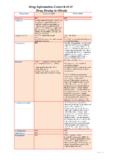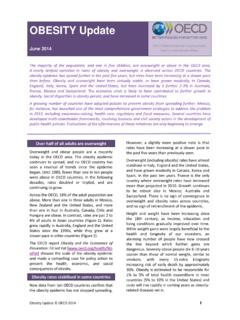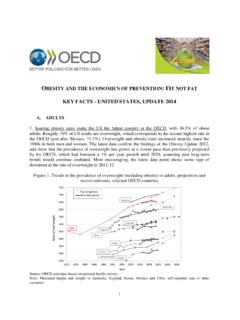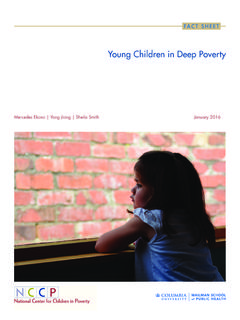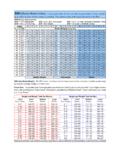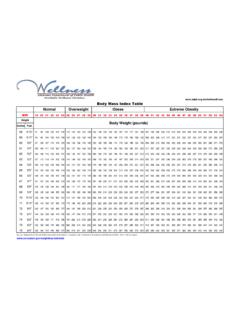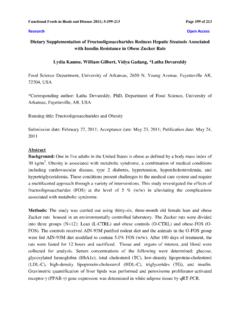Transcription of Childhood Obesity in the United States - NCCOR
1 BackgroundChildhoodob esit y is a serio us y, nearl y a thirdof yo uth s are overwei gh t or obese . Th at smor e than 23 million childrenand teen , 2 The te rm ob ese describeschildrenand adolescentswho ha ve a body ma ss inde x (B MI ) at or ab ove the 95thperc enti le forth eir ge nd er and age, wh ile overweight describesth ose wi th a BMI at or abovethe 85thbu t bel ow th e 95thperce ntil lt hy Pe op le 2010calledfor a reductionin th e proportionof overw eight and obesech ildrenan d adolescentsto 5%,but ha s fa iled to mo ve to wardthis ce 19 80 , th eobes ity ra te ha s morethandou bled ( to 12 .4%)am ong child ren aged 2-5 years,almosttripled(6. 5% to 17%)am ong child ren aged 6-1 1, and more thantripled( )in adolescentsaged12- 19 eve ntingob esit y during Childhood is critical,becausehab its form ed duringyo uth frequentlycarryinto adulthood.
2 An obe se 4-year-old has a 20% ch anceof becoming obeseas an adult , and an obeseteen ag er has up to an 80%chance of bec om ing an this epide mic is notreversed, we are in danger of raisingth e first gen era tion ofAm eric an child re n who will live sick er and die youn ger th anth e ge ne rat ions Ove rwe ight and obesityare asso ciatedwith a 52% and60%inc rea se d risk , respectively, for new diagnosesofast hma am ong childrenand ado Ob ese children are at a hig her risk for psychosocialpr ob le ms, fa tt y liver,ortho pedic-relatedproblemsandslee p apnea .8 Alt houghtrad it ionallyviewedas an adult illn ess, the risein child hoodove rweight and obesityhas correspondedto an inc re asing pro po rtio n of you ths with type 2 diabetes,pa rt ic ularl y am ong adolescent , 10 Ob ese childrenand teen s havebeenfoundto have riskfa ct ors for card iovascular disease(CVD),includinghighchol est erol lev els, hig h blo od pressureand abn ormalglu co se tole ranc a popu la tion -basedsam ple of 5- to17-year-o lds, 7% of obesechildrenhad at leaston e CVDrisk fac tor while39 % had two or more CVDrisk o many child re n have an energy im balance.
3 Th ey r e takin gin mo re ca lo ri es than the y burn .13 Myria d fa ct ors ma y fuelthi s imb al anc e, suchas: Overw ei ght ad ol escentsage d 12-17yea rs consumebetw een700 to 1, 000 more cal ori es per da y thanwhat s nee ded forthe gro wth, physica l ac ti vi ty and body func ti on of a he al thywe ig ht tee n. Ove r th e co urse of 10 ye ars, thi s exce ss canpa ck on 57 unne ce ssarypo un Chi ldre n and ad olesc ents ag ed 8-18ye ars sp end , onavera ge , more than si x hou rs per day watc hi ng te levi si on ,pla ying vi deo game s and using othe r type s of med ia .14 In 20 01, 16%of scho ol-aged chi ldre n wa lked or bike d tosc ho ol as co mpare d to 42%in 19 69. Di stan ce, we ath er,fea r of crime s against ch ild ren and in ad eq uate wal kingpat hs all con tri bu te to thi s diffe renc Onl y of high sc hools, 7.
4 9% of middle sc hool s and el eme nt ary sc ho ol s pro vid e da il y physica l ed uc ation orit s eq ui vale nt (225 mi nute s per we ek for mi ddl e and hi ghsc hool s and 150 minutes pe r week fo r elementar y sc hool).16 Racial/EthnicdisparitiesThe preva le nce of obesi ty is ri sin g fa ster am ong bla cks andHisp ani c ch ildre n, acco rd ing to an ana lysi s of data from theNat io nal Long itu di nal Su rvey of Youth . Ove r 10 ye ars, obesi tyincre ase d mo re tha n 120%amo ng bla cks an d Hi sp an icswhi le incre asi ng by more than50% in whi : Non -His panic black an d MexicanAmer ican girls weremo relike ly to have a high BMI for age than non -Hispanic whit egirl ost 28 % of no n- Hisp ani c blac k te ena ge gi rlsage d 12- 19 and alm ost 20%of Mexi ca n Am eri can te ena gegir ls wer e at or ab ove the 95t h percentile of the 2000BM I-fo r- ag e growt h ch ar ts co mpa red wi th 14.
5 5% ofno n- Hispa ni c white girl Amo ng boys, MexicanAm ericans weresignificantly mo relikelyto ha ve high BMI fo r ag e thannon -Hispanic whitebo ys. No n-Hispanic blackbo ys, ho wever,wereonly morelikelytha n non-Hispanic whitebo ys to have high BMI forag e at the hig hest BMI-f or-ag e level(BMIfor age 97thper ce nt ile) .2 Bla ck and Hisp anic childrenare sign ificantlyless likelythanwhitechild ren to get invo lved in organ iz ed ph ysicalacti vityoutsid e of scho ol. Am on g childrenag ed 9-13 years,24 .1 %of bla ck s and Hispanicsare involvedin or ganizedphys ica l ac tivity outsideof scho ol comparedwith 46 .6 %of whit dhood obe sit y al one is estimated to cost $14 billionannua lly in dire ct hea lt h expenses , and childrencov eredby Medi ca id are ne arl y si x ti mes more like ly to be tre atedfor a dia gn osi s of obesi ty tha n ch ildre n covered by priva teinsurance.
6 19 Whil e the re are many cau se s of sc hool ab se nte eism, ast ud y ana lyz in g the attendan ce patterns of fourt h-, fif th-and si xt h- grad ers in Ph il ade lp hia fo und ob ese chil dre n ar eabs en t sign ificantly mor e than av er age- abse nte eism hurt s stu den ts lea rnin g, cau ses par en tsor gua rdia ns to mis s work, an d is co st ly to school sy st ems .Amo ng the st ud y po pu lati on, obese chi ldre n missed anav er age of day s of schoo l per year, whileav er age- weightchil dre n missed 10 .1 days, on ave ra ge .20 ChildhoodObesityintheUnitedStatesReferen ces1) Resident Pop ulationPr ojections by Sex an d Age 200 5 to 2050 . CensusBureau,StatisticalAbst ract of the UnitedSt ates, ble 12.
7 Htt ab/p op .pd ) Og de n CL, Ca rroll MD and Fleg al, KM. Highbod y ma ss ind ex for age am ong . ch ildrenand adolescents, 20 03-2006. Jour na l of the AmericanMedicalAsso cia tio n, 299(20):2 40 1- 24 05 , 2008 .3) Hea lthy Peo ple 2010 Midcourse Re . Depart men t of He al th and HumanSe rvic es, ov/Data/midc ourse/ht ml/focusa re as/FA19Pr ogre ) Og de n CL, FlegalKM, Ca rroll MD, et al. Pr evale nce and tre nd s in overweightamo ng U. S. chi ld ren and adolescents, 1999-2000. Jo ur nal of the Am ericanMe dicalAssoc iat ion . 288 (14 ): 17 28 -1 732, 20 ) Guo SS , ChumleaWC. T rack in g of bod y massin de x in ch ildr en in relatio n to overweig ht in adulthood. AmericanJournalof Cli ni cal Nut rit io n.
8 70(suppl): 145S-148S, ) OlshanskySJ, Passaro DJ, Hershow RC, et al. A pote ntial decl in e in lif e expectancyin the UnitedStatesin the 21st century. Ne w Eng land Jour nal of Me dicine,352(11):11 38-1145,20 ) Gilliland FD , Berha ne K, IslamT, et al. Ob esit y and the risk of new ly diagnosedasthmain scho ol- age ch ildren. AmericanJo urna l of Epidemio lo gy, 158( 5): 406 -415, ) Kershnar A, DanielsS, Im peratore G, et al. Lip id abn ormalities are prevalent in youthwith type 1 and typ e 2 di abetes:The SEARCH fo r Dia betesin YouthStudy. The Jou rnal of Pediatrics,149( 3) :31 4- 319, 20 ) Ove rweight and Obe sity. Cen ters for Dise ase Con tro l an d Pr eve nti on .htt ov/n ccdphp/dn pa/obesit y/childho od/c onse qu en tm10 ) The Writ ing Groupfor th e SEARCH for Diab et es in You th Stud y.
9 In cidenceof diabetesin yo uth in the Uni ted States . Journalof the Ame ri can MedicalAsso cia tio n, 297:2716-272 4, 20 07 .11 ) Dietz W. Hea lth consequence s of ob esit y in yout h: Childhood pre di ctorsof adultdisease. Pediatrics, 101: 518-525, ) Freedman DS, Mei Z, Srin ivasanSR , et al. Car diovascula r risk fa ct ors and excessadiposity amongoverweight childrenand adol esce nt s: the BogalusaHeartStudy. Jour nal of Ped iatrics,150 (1) :1 2- 17, 200 ) WangYC, Gor tmakerSL, So bol AM and Kunt z KM. Est imat ing the energygap children:A counterfactualapproach. Pe diat ric s, 118:1721-1733, ) Rideo ut V, Rober ts DF and Foehr UG . Exe cu tive Summary: Gen erati on M: Mediain the live s of 8- 18 -ye HenryJ.
10 Ka iser Famil y Foundation, g/en tmedia /upload/G en era tion -M -Me dia- in- th e- Li ves- of-8- 18-Y ) KidsWalk -t o-S chool:Th en an d Now Ba rrie rs an d Solu tion s. Cen te rs for DiseaseCo ntr ol and ov/n ccdphp/dn pa/kidswalk/t he n_a nd ) School Hea lth Polic ies an d Pr ograms St ud y 20 06: Overview. De partmentof Healthand HumanServices:Centersfor DiseaseCo ntr ol and Prevention, ov/HealthyY out h/sh pp s/2006/fa ct she et s/pd ) StraussRS and Polla ck HA. Epi de mic inc re ase in child hoodoverw eight,1986-1998. Journalof the AmericanMedicalAss oci at ion, 286( 22) :2845-2848, ) Duke J, Huhman M an d HeitzlerC. Ph ysical act ivity leve ls amo ng childrenaged9- 13 years UnitedSt ates,2002.



